#sarcoma of the bone
Explore tagged Tumblr posts
Text
Sarcoma Bone Cancer Treatment in Dubai
Expert care for sarcoma bone cancer in Dubai. Comprehensive treatment and support at Hope AMC for a healthier future.
youtube
0 notes
Text
Patient Success Story -Thigh Bone Osteosarcoma - Dr Srinath Guptha Basavatarakam Cancer Hospital.
Meet a brave young patient from Telangana who was diagnosed with Thigh Bone Osteosarcoma, a challenging form of bone cancer. His journey of hope and healing is a testament to the advancements in medical science and the expertise of our skilled team.
Under the careful guidance of Dr. Srinath Gupta, our Consultant Orthopedic Oncologist, this young patient underwent a specialized surgical procedure to successfully remove the tumor in the middle of the thigh bone. The bone was then treated with liquid nitrogen to eliminate cancer cells, followed by an innovative reconstruction with a 3D-printed plate to preserve growth potential and functionality. 🦴
This breakthrough approach highlights our commitment to providing cutting-edge treatment options to ensure the best possible outcomes for our patients.
🎥 Watch this video to discover the inspiring journey of a young patient and the remarkable surgical care that contributed to his recovery.
#bone cancer#sarcoma cancer#Bone Osteosarcoma#basavatarakam cancer hospital#basavatarakam#best cancer treatment in india#basavatarakam hospital#best cancer specialist in india#basavatarakamcancerhospital basavatarakam#indo american cancer hospital#indo american hospital#best cancer hospital#best cancer hospitals in india#Dr Srinath Gupta
1 note
·
View note
Text
Exploring Bone Sarcoma: Variants, Therapeutic Approaches, and Future Prospects
Bone sarcoma, a rare type of cancer, affects the bones and surrounding tissues. The condition comprises various types, including chondrosarcoma, Ewing sarcoma, and osteosarcoma, each presenting unique challenges in treatment. However, recent advancements in therapies offer hope for improved outcomes in managing bone sarcoma. Challenges Associated with Bone Sarcoma Treatment: Bone sarcoma…
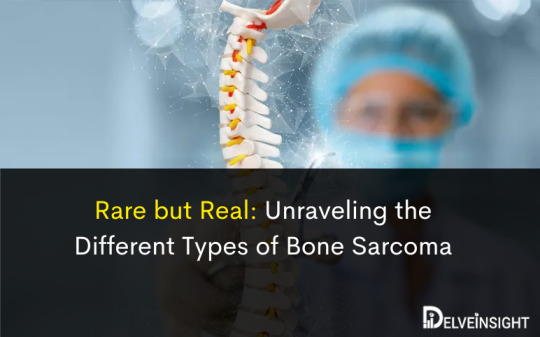
View On WordPress
#Bone Sarcoma#Bone Sarcoma Companies#Bone Sarcoma Types#Chondrosarcoma#Chondrosarcoma Drugs#Chondrosarcoma Market#Chondrosarcoma Treatment#Ewing Sarcoma#Ewing Sarcoma Drugs#Ewing Sarcoma Market#Ewing Sarcoma Treatment#Osteosarcoma#Osteosarcoma Companies#Osteosarcoma Drugs#Osteosarcoma Emerging Therapies#Osteosarcoma Market#Osteosarcoma Treatment#Osteosarcoma Treatment Market
0 notes
Text
Toronto Childhood Cancer Staging criteria for Ewing sarcoma Calculator
Ewing sarcoma treatment usually begins with chemotherapy and/or radiation followed by surgery to remove any remaining cancer. Treatment options for recurrent sarcoma include targeted therapy and high-dose chemotherapy with stem cell transplant.
0 notes
Text
hi, i'm silver vk, genderfucked net freak. you might remember my posts, books, memes, etc under the name frog k, paris green, enmity ironside? whichever. i'd normally put a buncha links here but i'm kind of in a state so forgive me if i don't have it in me.
my gf and i have been struggling for a while, disease disability poverty etc etc, and sometime in that, our cat maggie got sick. bone sarcoma; she kept it entirely to herself until it was way too late. she stopped eating, then stopped being able to really move, at the end of june. even now i kind of have a hard time putting together the words to express how much she meant to me and how much i miss her.
putting maggie to sleep was expensive. i am glad i did it, because seeing her suffer was hell. but i am now extremely broke and running out of food; i could use help more than anything.
hoping to raise $700; any help deeply appreciated, reblogs on this & other platforms always welcome.
cashapp - $asimplefrog ko-fi (paypal redirect) - frogk
thank u 💔
982 notes
·
View notes
Text

Happy Feast Day
Blessed Chiara Luce Badano
1971 - 1990
Feast day: October 29
Blessed Chiara Badano was born on October 29, 1971, to Ruggero and Maria Teresa Badano in Sassello, Italy. The couple waited and prayed eleven years to have Chiara. At age nine she joined the Focolare Movement and received the nickname "Luce" by the founder Chiara Lubich. When she was 16 she was diagnosed with osteogenic sarcoma, a painful bone cancer. Chiara succumbed to cancer on October 7, 1990, after a two-year battle with the disease.
Prints, plaques & holy cards available for purchase. (website)
88 notes
·
View notes
Text
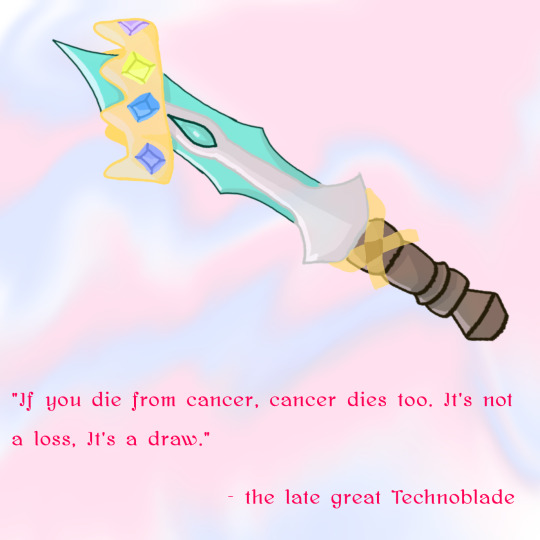
Tribute to the greatest youtuber and minecraft player to ever live; Technoblade.
Happy World Cancer Day! The drawing is a bit rushed, but I just wanted to post a tribute to Technoblade.
Technoblade was the person who would have enemies and turn them into friends. Allies. His jokes always made his viewers laugh, including me, even after a bad day. He's the type of creator who's content you'll get hooked to. You watch one video and then proceed to watch the rest. There will never be another like him.
February 4th is celebrated as World Cancer Day, and brings recognition to cancer. The yellow ribbon I included around the sword is the representation of the rare and deadly sarcoma, a cancer that affects fats, muscles, blood-vessels, bones, nerves and other connective tissues. I would heavily recommend doing your reasearch on cancer. We lost the Blood God to this disease, and he rests so that we can work to stop us from losing others. It is a deadly killing machine that looms over us at all times. We must fight back.
#art timelapse#mcyt#technoblade#minecraft art#minecraft smp#dream smp#hypixel#cancer#sarcoma#worldcancerday
35 notes
·
View notes
Text
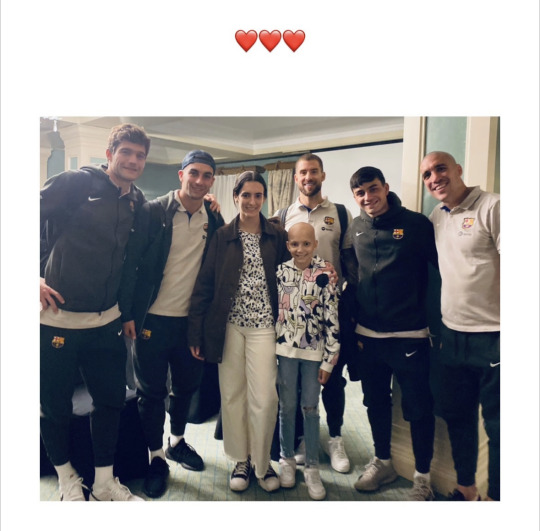
After arriving at their hotel in Madrid yesterday, Pedri, Ferran, Iñigo, Oriol Romeu and Marcos Alonso spent over one and a half hours talking to the wonderful Maria Caamaño Múñez, a little football fan who has been fighting Ewing Sarcoma (a rare type of bone and tissue cancer) for the past four years ❤️
vía mariacmfutbolera and __luuciacm

#pedri#pedri gonzalez#ferran torres#oriol romeu#iñigo martinez#marcos alonso#fc barcelona#fc barça#barça
74 notes
·
View notes
Note
I regret to inform you that you’ve just been diagnosed with Acute Lymphoblastic Leukemia, Acute Myeloid leukemia, Kaposi Sarcoma, Primary CNS Lymphoma, Anal Cancer, Appendix Cancer, Astrocytomas Brain Cancer, Atypical Teratoid Brain Cancer, Bile Duct Cancer, Bladder Cancer, Bone Cancer, Brain Tumors, Bronchial Tumors, Lung Cancer, Burkitt Lymphoma, Carcinoma, Germ Cell Tumor, CNS Lymphoma, Cervical Cancer, Cholangiocarcinoma, Chronic Lymphocytic Leukemia, Chronic Myelogenous Leukemia, Colorectal Cancer, Craniopharyngioma, Cutaneous T-Cell Lymphoma, Endometrial Cancer, Introcular Melanoma, Retinoblastoma, Gallbladder Cancer, Gastric Cancer, Gastrointestinal Neuroendocrine Tumors, Gastrointestinal Stromal Tumors, Head and Neck Cancer, Heart Tumors, Hepatocellular Cancer, Hodgkin Lymphoma, Kidney Cancer, Leukemia, Lung Cancer, Liver Cancer, Lip and Oral Cavity Cancer, Laryngeal Cancer, Melanoma, Mycosis Fungoides, Myelogenous Leukemia, Myloproliferative Neoplasms, Mesothelioma Malignant, Nasal Cavity and Paranasal Sinus Cancer, Neuroblastoma, Nasopharyngeal Cancer, Panceatic Cancer, Papillomatosis, Paraganglioma, Pheochromocytoma, Pituitary Tumor, Penile Cancer, Prostate Cancer, Rectal Cancer, Rhabdomyosarcoma, Retinoblastoma, Salivary Gland Cancer, Kaposi Sarcoma, Osteosarcoma, Skin Cancer, Vascular Tumors, Stomach Cancer, Throat Cancer, Oropharyngeal Cancer, Hypopharyngeal Cancer, Thyroid Cancer, Thracheobronchidal Cancer, Thymoma, and Thyric Carcinoma.
-Dr. Homeless
oh shit
5 notes
·
View notes
Note
'Whats your favourite flavour of cancer'
Bill wtf?? Lmao??
Bill thinks bone sarcomas taste best, particularly an untreated grade I chondrosarcoma that's really been left to marinade—but there's something romantic about basal cell carcinoma, isn't there? In a poetic way.
49 notes
·
View notes
Note
is the yellow ribbon for the military or suiside Prevention you dont have to answer.
It's the ribbon that represents sarcoma/bone cancer. It's in remembrance of Technoblade, as he was a huge inspiration for me. His death affected me quite a bit despite not knowing him personally. Technoblade never dies.
30 notes
·
View notes
Text
Neoplasms of Bone
Just like when I talked about tumors of the CNS, this list is not all-encompassing. This convers what I'm pretty sure board exams are concerned with, but don't quote me on that.
Alright, so you have two broad categories of tumors: primary and metastatic (spreading from somewhere else). Primary bone tumors are rarer and are found in the long bones of the extremities. Most are asymptomatic, slow-growing, and benign. The benign ones we'll talk about are osteoid osteoma, osteoblastoma, osteochondroma, chondroma, and giant cell tumors. The malignant ones are osteosarcoma, Ewing sarcoma, and chondrosarcoma. The metastatic bone tumors don't have fancy names because they're really lung cancer or whatever.
Osteoid Osteoma
These tumors have no malignant potential, and are less than 2 cm in size. They're more common in males less than 25 years old, and in the long bones, face, and skull. An interesting syndrome is called Gardner's Syndrome, which causes adenomatous polyposis, osteomas, and soft tissue tumors.
Osteomas are slow growing and show a thick rim of reactive cortical bone on x-ray. They also cause nocturnal bone pain that is relieved by Aspirin and NSAIDs.
These and osteoblastoma have similar histological features, which is a trabeculae of woven bone with a single layer of prominent osteoblasts forming a rim. There will also be loose connective tissue with dilated and congested arteries. Reactive bone will encircle the actual tumor. The two also have similar gross features, which is a roundish, well-circumscribed mass of hemorrhagic, gritty tan tissue.
You treat osteoid osteoma with radiofrequency ablation.
Osteoblastoma
These are greater than 2 cm in size and are also common in males less than 25 years old. They arise in the spine, and cause pain that is all day and not relieved by Aspirin or NSAIDs. That's how you tell the two apart clinically. To treat, you just cut that bitch out.
Osteochondroma
These are fairly common and 85% of them are sporadic. The other 15% are part of multiple hereditary exostosis syndrome. You're going to see these near the growth plate on the metaphysis of long bones. They will be palpable and are basically a little knot attached to the skeleton via a bony stalk and capped with cartilage. They can cause pain if they impinge on a nerve.
Histologically, you'll see a disorganized growth plate, which undergoes endochondral ossification, and a cartilage cap lined by perichondrium (continuous with mature bones).

Chondroma (Enchondroma)
This is a benign tumor of hyaline cartilage. They're usually well-circumscribed nodules less than 3 cm in diameter. The cut surface will be gray-blue and kinda see-through. On x-ray, you'll see irregular calcifications, sclerotic rims, and an intact cortex.
Two conditions are associated with these. Ollier disease causes enchondromas that are on one side of the body and limited to the limbs. It also causes an increased risk of gliomas and ovarian tumors. Maffucci syndrome also causes spindle cell hemangiomas and gliomas.
Giant Cell Tumors (Osteoclastoma)
This is a rare benign tumor of multinucleated osteoclast-type giant cells. Locally, it is aggressive. 4% of cases metastasize to the lungs, but may regress spontaneously. These are rarely fatal.
You're most likely to see these at the knee, and observe arthritis-like symptoms. They may cause fractures and destroy the overlying cortex, resulting in a bulging mass of soft tissue. Grossly, these are large, red-brown masses that frequently cystically degenerate. Histologically, you'll see uniform oval tumor cells and a bunch of osteoclast-type giant cells with over 100 nuclei. Necrosis and mitotic activity can be prominent. X-ray shows a characteristic soap bubble (shown below).
To treat, cut the bitch out. 40-60% reoccur locally.

Osteosarcoma
This is the most common primary malignant bone tumor. These are more likely in people younger than 20, those with Paget disease, bone infarcts, and prior radiation. Half of cases are in the distal femur or proximal tibia (so the fucking knee).
The peak incidence is at the growth spurt of youth, and at the growth plates of rapidly growing bones (your fucking legs). These are painful and cause bone fractures. X-ray may show infiltrative margins, lifting of the periosteum, and reactive periosteal bone formation. This includes patterns like the Codman triangle (aggressive), or a Sunburst pattern. These are due to the fact that the bone cannot grow fast enough to cover the tumor.

These are bulky, gritty, gray-white tumors. Typically with hemorrhage and cystic degeneration. It will destroy the surrounding cortices to make soft tissue masses and spread into the medullary canal, replacing hematopoietic marrow (so less RBCs are gonna be made). Histologically, you're gonna see pleomorphism, large hyperchromatic nuclei, bizarre tumor giant cells, and mitosis. It can be described as "lace-like."
To diagnose, you need the presence of malignant tumor cells making unmineralized osteoid or mineralized bone. All cases are assumed to have occult metastases, such as those to the lung, bones, brain, etc. The 5-year survival rate is less than 20% for those with metastases.
Ewing Sarcoma
This is another malignant one, and common in the femur, pelvis, humerus, and ribs. 80% of cases are in those under 20. These are painful, enlarging masse that cause the affected site to be tender, warm, and swollen. Systemic findings will show elevated EST, anemia, and leukocytosis. X-ray will show a lytic tumor with moth eaten margins and reactive bone with onion-skin layering (seen below). Grossly, these are soft, tan-white tumors with hemorrhage and necrosis. Histologically, you can see a uniform sheet of small, round cells and scant cytoplasm. You'll also see Homer-Wright rosettes.
Treatment is chemotherapy plus excision, which yields a 75% 5-year survival rate.

Chondrosarcoma
These are painful, progressively enlarging masses that produce cartilage. They are classified as conventional, clear cell, dedifferentiated, or mesenchymal. They're typically found in the axial skeleton.
These are bulky tumors that grossly appear as gray-white nodules of see-thru cartilage. The matrix is usually gelatinous and they'll ooze from a cut surface. There may be spotty calcifications and cystic spaces. Histologically, there is cytologic atypia and mitotic activity.
Treatment is wide excision (conventional) or excision and chemotherapy (mesenchymal and dedifferentiated).
Metastatic Bone Tumors
Not a lot to say on these, as they appear histologically as whatever cancer they came from. But 75% of them are going to come from the prostate, breast, kidney, or lung (in adults, anyway). X-ray may show lytic or blastic (destroying or forming) lesions. Sometimes it's mixed. Bidirectional interactions between the cancer cells and the bone cells cause changes in the bone matrix. Tumor cells stimulate osteoclast activity (bone destroying).
Treatment is symptomatic pain relief, radiotherapy, and use of bisphosphonates zoledronic acid to prevent further metastases. The prognosis is poor.
2 notes
·
View notes
Text
Hi,
My names Skye, I’m Craig’s daughter in law and mum to his grandson Karter.
Im setting this go fund me up to support Craig, Rachel and the kids during his difficult time during his 2nd relapse of leukaemia.
Craig was first diagnosed with leukaemia back in 2020, with lots of rounds of chemotherapy, relapsing and being given the gift of a bone marrow transplant from his amazing brother that saved his life. The past 2 years Rachel and Craig started to rebuild their life following the amazing results from the transplant and financially started to rebuild on their finances with Craig being able to return to work with the focus on building more memories for the future. Craig has grown within himself as a man, made amazing memories with his wife Rachel, the kids and lots of family and friends and really made the most of his life as you can never take life for granted. Rachel and Craig then experienced a special gift of their 1st grandchild, and they really are most amazing grandad and nanna to Karter.
Unfortunately yesterday Craig got the news he has relapsed for a 2nd time, however this time the cancer is know as leukaemia sarcoma a very rare tumour in his head. Dr’s have informed us that it is a very aggressive large tumour that is rapidly spreading to his brain. We are all completely devastated with this news and know this will have a massive impact on finances for the 2nd time. Today Craig will start intensive chemotherapy and has got a long fight ahead of him.
Words from his wife Rachel:
Craig sheehan, Is one incredible man who fought this disease once before and beat it. Time to stand up and fight again it’s going to be a very difficult and uncomfortable battle but I know Craig will give it everything he’s got he’s a warrior.
Everyone who knows Rachel and Craig know how amazing they are, they would be the first to go out of there way to help other people. They now need our HELP and support during this difficult time. Rachel is doing an amazing job looking after Craig, the kids and holding the family together. Things financially are going to be very difficult for them especially with Christmas fast approaching. Please if you’re able to help in any way it would be really appreciated, no matter how small. Let’s get behind this amazing family and show them all how much we love and care for them.
Love to you all remember to enjoy the small stuff as you will know in time they are the most important!❤️
#donations#gofundme#fundraising#nonprofit#donate#philanthropy#crowdfunding#charities#planned parenthood#volunteering
7 notes
·
View notes
Text
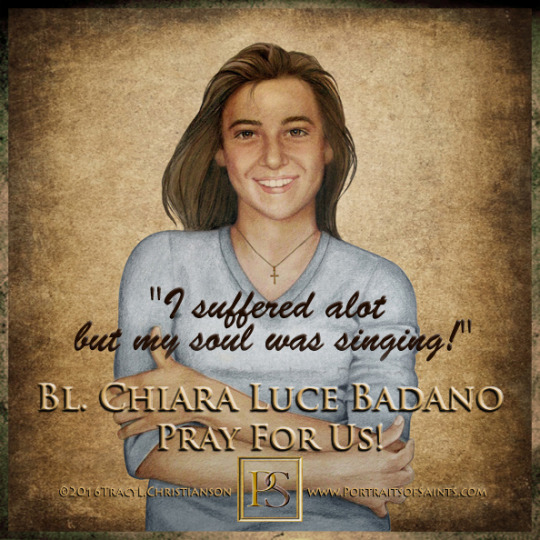
Blessed Chiara Luce Badano
1971 - 1990
Feast day: October 29
Blessed Chiara Badano was born on October 29, 1971, to Ruggero and Maria Teresa Badano in Sassello, Italy. The couple waited and prayed eleven years to have Chiara. At age nine she joined the Focolare Movement and received the nickname "Luce" by the founder Chiara Lubich. When she was 16 she was diagnosed with osteogenic sarcoma, a painful bone cancer. Chiara succumbed to cancer on October 7, 1990, after a two-year battle with the disease.
Prints, plaques & holy cards available for purchase here: (website)
75 notes
·
View notes
Text
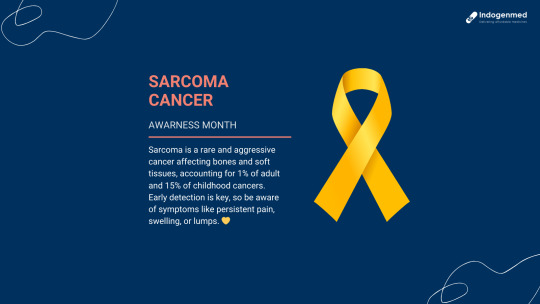
Sarcoma, often called the "forgotten cancer," affects the body's connective tissues like bones and soft tissues. Despite being rare, it's important to spread awareness and support those affected. Soft tissue sarcomas, the most common type, can appear in muscles, fat, blood vessels, and more. Early detection is crucial, so watch for painless lumps that may grow and become painful. Together, let's bring attention to this often overlooked cancer and support those on their journey.
2 notes
·
View notes
Text
Incase you didn't know. This is what the different ribbon colors mean!
❤ - The red ribbon represents AIDS/HIV, alcohol and substance abuse, Vasculitis, love, heart, and disease.
🧡 - The orange ribbon represents hunger, leukemia, animal protection awareness, self harm awareness, multiple sclerosis, ADHD (attention defficent hyperactive disorder) and kidney cancer.
💛 - The yellow ribbon represents supporting our troops, suicide prevention, genocide awareness, sarcoma and bone cancer awareness.
💚 - The green ribbon represents tissue and organ donations or transplants, mental health, mental illness, leukemia, environment, kidney neural tube defects, save the earth movement, go green movement, and the recycling movement.
💙 - The blue ribbon represents child abuse prevention, arthritis, sex trafficking and slavery, and prostate cancer.
💜 - the purple ribbon represents Sarcoidosis lupus, fibromyalgia, religious tolerance, violence against women, domestic violence, cycstic fibrosis, Alzheimer's disease, pancreatic cancer, and epilepsy.
Violet - Hodgkin's lymphoma.
🤍 - The white ribbon represents victims of Terrorism, peace, blindness, and Holocaust Remembrance.
🖤 - The black ribbon represents mourning and melanoma.
Lime green - The lime green ribbon represents lymphoma, Non-hodgkin's lymphoma, muscular dystrophy, and mental health.
Teal - The team ribbon represents gynelogicial cancer, and sexual assault.
Periwinkle - The periwinkle ribbon represents eating disorders, pulmonary hypertension esophageal cancer and stomach cancer.
💗 - The pink ribbon represents breast cancer.
Cream - The cream ribbon represents Paralysis, spinal cord injuries, spinal diseases and disorders.
Light Blue - The light blue ribbon represents prostate cancer and men's health.
Lavender - The lavender ribbon represents all cancers (general cancer awareness), and Eplisey.
Pearl - The pearl ribbon represents lung cancer and lung disease, and multiple sclerosis.
Gray - The gray ribbon represents diabetes, brain cancer, and asthma.
Silver - The silver ribbon represents Brain disorders.
Gold - The gold ribbon represents childhood cancer.
Zebra Patterned - The zebra patterned ribbon represents rare diseases and cancers, such as nueroendocrine, tumors, carcinoid cancer, Ehlers-Danlos Syndromes and Whipple's disease. These are just examples, this is not excluding any other rare dieseases or cancers. (Credit to @
Hope this helps someone! If I'm missing one or got one wrong, let me know in my asks box.
4 notes
·
View notes